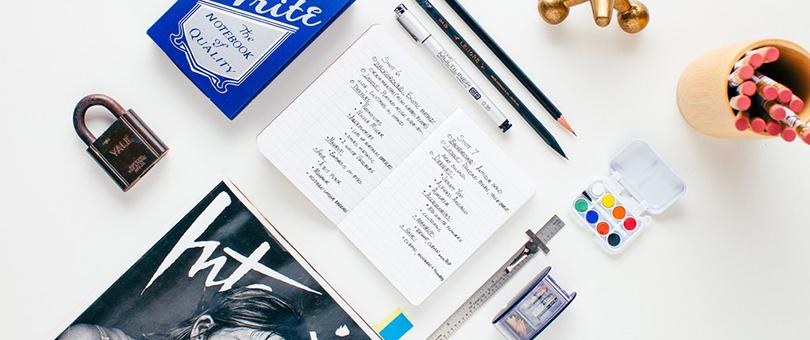In 2009, I bought the last wall calendar I would ever own.
The same year, Google Calendar graduated from beta, and every day since, new technologies emerge to help us communicate and design and schedule our lives, threatening paper’s extinction with each download. But, although snail mail volume is on a sharp decline, we are somehow still consuming as much paper as we always did, maybe more. (Toilet paper: there isn’t an app for that.)
I’m a pen and paper holdout in many ways – the slightly musty smell of an old library book, the satisfaction of crossing out items on my notebook to-do list, the way a toothy paper soaks up India ink. I’m not alone. And these die-hards, as app and tech heavy as they may be in other areas of their lives, are very serious about their paper.
That’s good news for Chris Rothe and Janine Vangool.
They both run successful, long-standing businesses on Shopify, selling goods proudly made from paper. Though their industries – notepads and magazines respectively – have taken a hit from paperless alternatives, they are thriving. Why? They’ve found their people. They’ve also strategically embraced technology as a means of reaching (and keeping) them.
Recently, we introduced you to the merits of niche marketing, and how to find small but passionate audiences for a unique product. Let’s dive into a few examples – these are the stories of two successful merchants keeping paper alive in a digital age.

Free Video Series: Ecommerce Inspiration
Feeling uninspired? Watch some of the world's most successful entrepreneurs share their best advice for new business owners.
Get our Ecommerce Inspiration video series delivered right to your inbox.
Almost there: please enter your email below to gain instant access.
We'll also send you updates on new educational guides and success stories from the Shopify newsletter. We hate SPAM and promise to keep your email address safe.
Meet Write Notepads & Co.
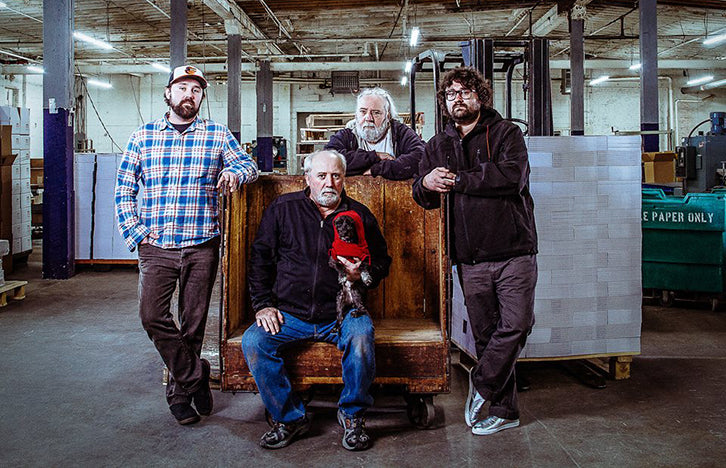
Chris Rothe is a third-generation commercial bookbinder. He and his brother have taken the reins in the family business. Well, almost. Chris laughs at my question about his father’s potential retirement plans – in true entrepreneur form, he’ll do what he loves until he physically can’t.
The commercial arm of the bookbinding business was established in 1969 by Chris’ grandfather, and the machinery continues to whirr, supporting a steady intake of corporate client work. Some of Chris’ oldest memories take place among those machines.
“Hell, I remember running heavy machinery when I was 9 or 10 years old. I was on summer vacation, working from 7:30 in the morning till 4 in the afternoon. There’s nothing like making things, starting with raw goods and then seeing how they become this final product. It's fun, it's fulfilling.”

After college, Chris knew he’d follow in the footsteps of his father and grandfather, but wanted to make his own mark on the business.
“I came to a crossroads where I grew to really, really dislike how that particular segment of the business worked – the B2B aspect. Our customers are large printing companies in the region and it was just soulless. It was just another job. Few things ever come across the plate that I would consider exciting. I hit this wall where I was like, ‘I really don't want to do it this way anymore.’”
In 2011, he followed a friend to SXSW, hoping to do some soul-searching. Rubbing elbows with creatives and entrepreneurs, especially in the digital realm, reignited his passion for the tactile. While on the trip, he realized that he needed to remain true to the roots of his family’s old world craft, but breathe into it a new life.
“I decided that if I was going to do something, it has to be actually making something. I came back from that trip and said, ‘Hey, you know what? We've got all this great machinery that we use for this terribly boring application on a day to day basis. Why can't we create a brand of our own and have fun with it?’”
And so a plan was put into motion: Write Notepads & Co. would became the newest member of the family. Unlike the scope of the commercial business, limited to a handful of corporate customers in the region, the consumer-facing Write allowed Chris to reach customers around the world.

“We now have freedom to create whatever we want. It's kind of scary. It's like being dropped in the middle of the ocean with no land in sight and you've got to somehow find and pick a direction and stay on course. Of course there are ups and downs, there are good days there are bad days. But being able to open a customer email thanking us for making an awesome product just makes it so worthwhile.”
Write Notepads was born as an idea in 2011, but didn’t go to market until late 2013. The existing business provided the financial stability and testing ground, affording Chris the time to get the product just right.
Chris banked on a market of people just like him – people particular about the pen-to paper feel, finicky about design and form. Like other industries, paper was enjoying throwback popularity. Consumers, shouting “enough with processed food”, are flocking to farmers’ markets, embracing slow food. Similarly, screen fatigue is driving more and more people back to old school craft and the art of handwriting and calligraphy.
“We continue to see growth as digital technology continues to grow itself. Media likes to create sides – this is black, this is white, no grey area. It's not like that. We all have to embrace both the digital and the analog. Schools in this country have gone away from teaching cursive and that's a big problem. There is a huge backlash in the aftermath and I think they've actually halted removing it from curriculum. You've got to take a stand. You can't kill off everything that once was and replace it with an iPad or an iPhone”
We're keeping an old perceived dead craft alive and using digital means to spread the word.
Why it Works
- Multiple revenue streams: the two sides of the business – commercial bookbinding and consumer goods – work to support each other through resource sharing, and picking up the slack during lulls.
- Versatility: Write Notepads can compete with the leaders in the industry because of their ability to accommodate low minimums for custom work.
“We can really throw our hat in the ring and take any company and put their logo on it. It could be as simple as companies that just want a one color on the cover, all the way up to full customization of stock, full color logos, a custom rubber band, and custom inside pages. Really the sky’s the limit. And, having all the manufacturing under one roof, we can offer some of the lowest minimums of anybody that's in our game.”
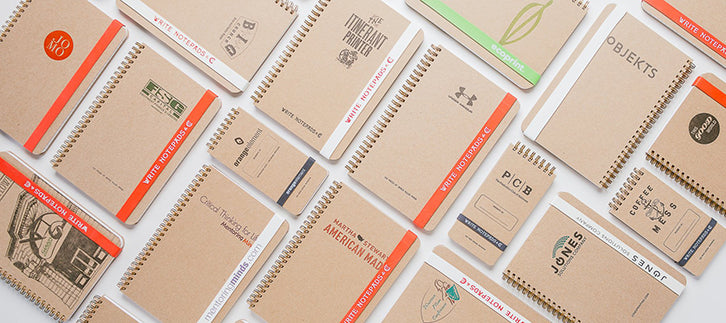
- Branding: From product page copy (“meticulously selected to perform best for most writing instruments”) to a carefully curated Instagram aesthetic, their branding game is strong and consistent. Form is almost more important than function here, and that’s evident in the messaging throughout the site. Family history and a dedication to “physical, textural charm” are woven into the narrative.
“We never stop looking for new papers, better papers. We're always R&Ding stuff like that.”
- Social responsibility: Though it’s an old school craft, companies like theirs need to adapt with trends and consumer awareness. Write offsets the impact of producing physical goods by committing to recycled materials – everything from the paper to the coil wire to the rubber bands are produced sustainably. Chris also invests in the local community, even more deeply rooting their brand in Baltimore pride.
 |
A great brand can help your products stand out from the crowd. Learn how with our free, high-impact reading list. |
Meet Uppercase

Janine Vangool opened her Shopify store in 2007, making her one of our longest standing customers. But her foray into commerce started quite accidentally. At the beginning of her career as a designer, she worked on many design projects for books and magazines. In 2005, she decided to move her office into an artists’ space called Art Central. One of the conditions of taking up residence, however, was offering a public component – the tenants couldn’t simply operate a design office.
“In the front of the space, I had an art gallery and a nice bookshelf of other people's books. I also made products to sell – greeting cards and sewn little bags. The front of the shop became kind of an experiment while in the back of the shop I doing design for clients and earning my rent.”
The experiment proved successful. She began to host gallery shows as well, selling the artwork in the shop, and eventually moving it online.
"Soon I became tired of working for clients and kind of got the entrepreneurial bug. I really liked having this space in the front that I could change and kind of experiment with and see what people liked. I had actual physical customers and then also these virtual customers coming in. That really piqued my interest and I started to shift my focus.”
Soon I became tired of working for clients and kind of got the entrepreneurial bug.
Uppercase – a magazine for “the creative and curious” – launched in 2009. Each issue centers around a theme related to art, craft or design, one month perhaps focusing on emerging illustrators, while the next highlights paper-making.
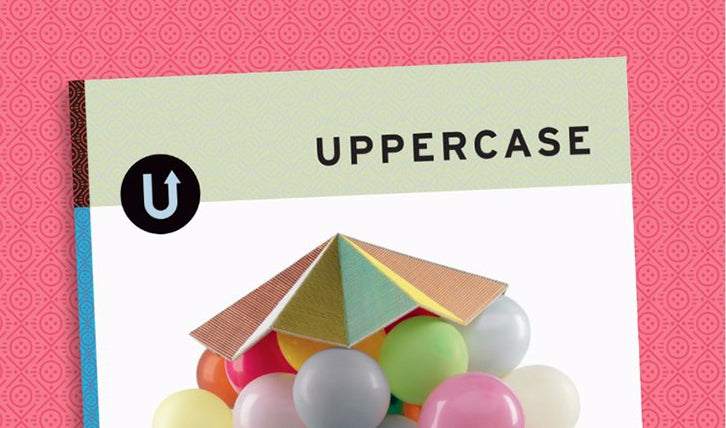
“One of the magazines I had been working for decided to stop publication so that freed up some of that magazine part of my brain. Learning that retail on its own is not sustainable for me, I thought a magazine would be a good, steady opportunity and to test some of my skills as a designer and as an editor and writer and curator and all those skills that I had learned by having this gallery shop.”
The year Uppercase published its first issue – on paper, of course – was the same year that the much loved Domino magazine stopped publication, followed by Martha Stewart’s Blueprint. All around her, other magazines were closing shop or moving digital, but she pressed on. She started small, aiming for (and gaining) 400 subscribers at launch.
Seven years and 5400 subscribers later, Janine has remained true to her dedication to print and paper. Her last issue’s print run was 14,000 physical copies. She’s vowed never to go digital, and she’s a woman of her word.

Though she has a stronghold on her analog ways, she has been fluid with business decisions and embracing technology that supports her product. She began selling subscriptions through her Shopify store before there was a clear and easy way to even do so on the platform. At the time, she hired a developer to get her Shopify store to talk to Salesforce, the tool she uses to manage subscriptions and liaise with the printer and fulfilment house.
“I wouldn’t recommend it,” she tells me, of the Frankenstein framework that enables the communication and process to function smoothly. Now, Shopify-compatible apps like Recurring Orders & Subscriptions by BOLD streamline this process for subscription based businesses. Janine has embraced other apps that have helped her sales – Product Upsell and Quantity Breaks being two heavy hitters for the shop, increasing her average order value.
At the time, she was also still selling one of a kind art and objects on the site, manually shooting and adding products, and shipping the items. She realized that it wasn’t sustainable.
“Basically, it was a good way of learning, but I quickly realized I don't really like doing that. Physically packing orders and dealing with the postal service on a real micro level was not fun. When I launched the magazine, I started looking for other ways of fulfilling. The printer could ship the magazines directly for me. I also connected my shop with Shipwire. That's when things really became a real system and I was able to grow by business with minimal staff – just me and a couple other people.”
That's when things became a real system and I was able to grow by business with minimal staff.
The offerings are now pared down to subscriptions, back issues, and a curated collection of books, many of them her own publications.
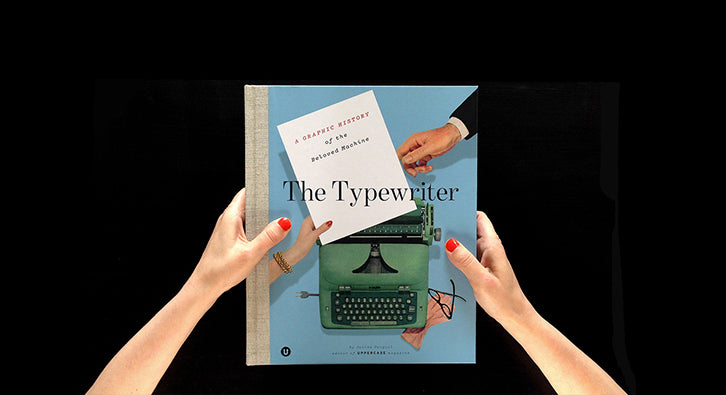
Uppercase has grown steadily over the past few years, with a high subscriber retention rate. She attributes the loyalty to listening. She carefully considers customer feedback, and uses submissions to gauge reader interest in specific topics. Through her Shopify store, she also sells back issues – sales data from these issues serves as her success barometer for the content, and helps dictate the themes for upcoming issues.
“Some issues sell out a lot more quickly than others. I react to that kind of information. I had an issue that was about quilting, for example, and it sold out faster than any others, so I know, ‘OK, there are a lot of people who like quilting.’”
The choice to stick with paper makes perfect sense for a magazine like Uppercase – her audience is a tactile bunch: artists, makers, and crafters. Janine partners with paper companies that align with her vision. While she recently announced that she wouldn’t be doing anymore advertising in the magazine, she’s approached partnership opportunities very strategically.
“I worked with Appleton Coated Paper – they're an American company, a small mill. They donated the paper for an entire issue. In return, there's an ad for them inside front cover. I did a little video showing it on press and thanking them for that donation. It was a really good fit because it just makes sense to print the magazine on their paper, and they wanted to reach my designer audience. I gave them an extra thousand copies that they'll use at design shows, too, which will be great exposure for me, too. That was a great partnership. I also invest in providing complimentary issues at conferences or workshops or retreats where my kinds of people might be.”
Though you can’t read Uppercase’s articles online, extra digital content is available exclusively to newsletter subscribers. Her list – 21,000 strong – gains weekly inbox access to bonus content and peeks behind the scenes. The newsletter is an excellent tool for converting email subscribers into magazine subscribers, through a welcome discount code.

Why it Works
- A dash of digital: Though the magazine will always be physical, Janine embraces the digital to gather customer feedback, source user-generated content, and create a community among readers through social media. Bonus digital content, also exclusive to email subscribers, is then used to build an email list and convert subscribers to customers.
- The right medium for the message: Uppercase’s reader base is primarily artists, many of whom still work in traditional materials, or those with an admiration for the craft. The matte velvety paper is the ideal medium to present the creative content, and begs to be clipped and pinned to inspiration boards.
- Branding: the choice to commit to analog is part of the brand identity. The magazine’s tagline, “For the Creative and Curious” speaks to a sense of discovery in every issue. Cryptic back cover copy not quite revealing inner contents, surprise goodies like illustrated bookmarks, and collectible boldly patterned spines all add to a hands-on experience that defines the brand.

- Green commitment: Like Write, one of the oldest materials gets a 21st century update – the magazine’s pages are printed on 100% post-consumer recycled stock.
It's about making things by hand, the tactile aspect. It's all about the physical object.
When considering starting a business selling a niche product to a small passionate audience, be sure to research your product’s viability and understand your ideal customer. Above all, take lessons from successful niche businesses like Uppercase and Write Notepads – be authentic with your brand, embrace trends, and always be evolving.
